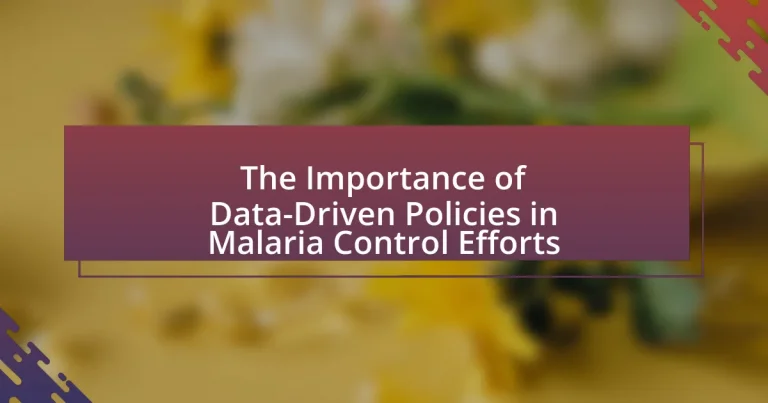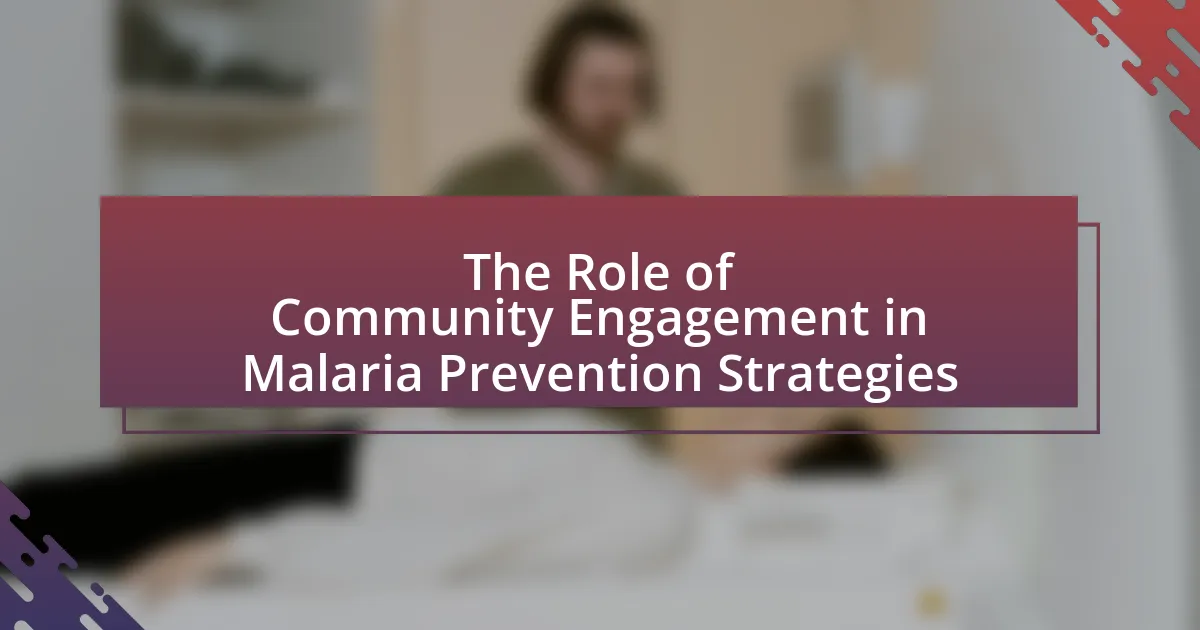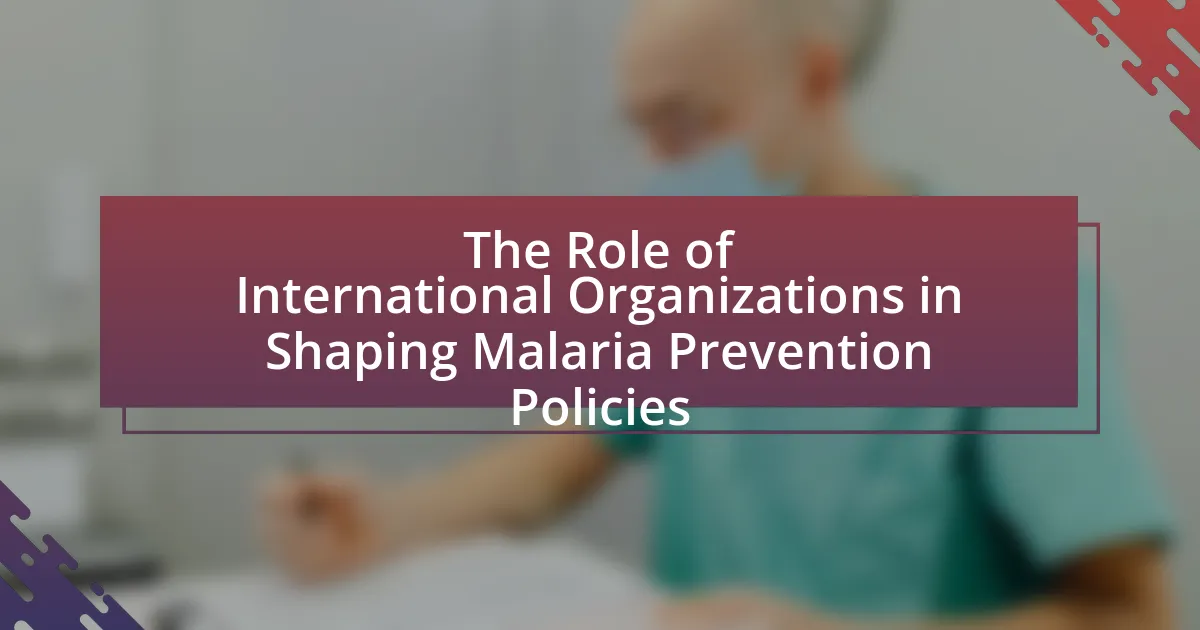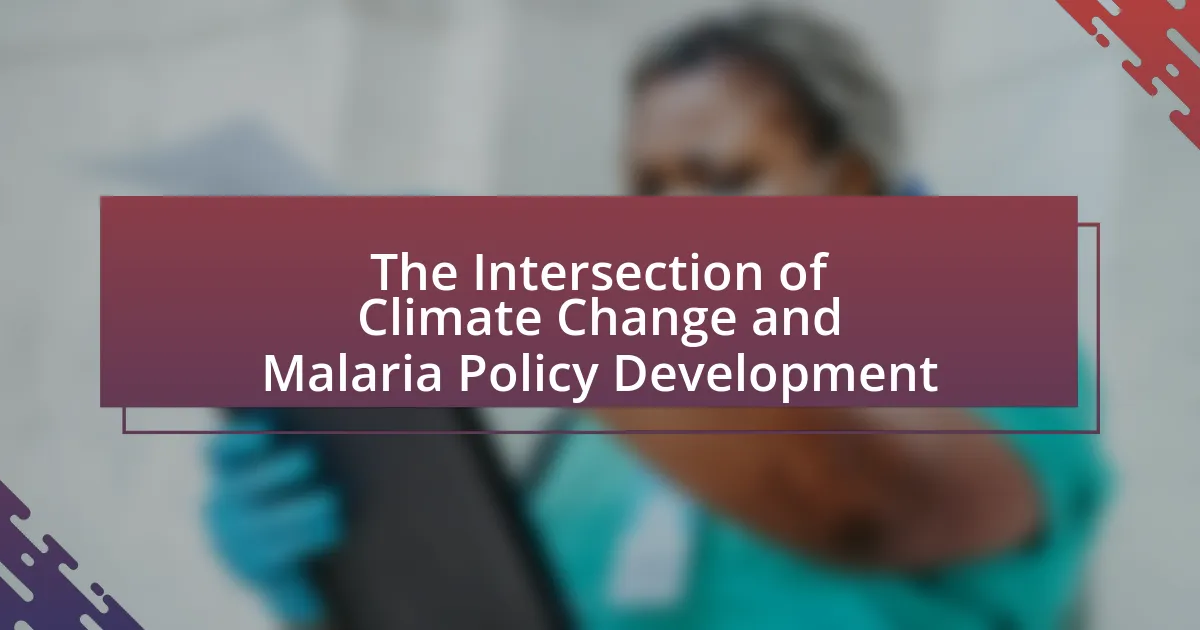Data-driven policies play a crucial role in malaria control efforts by utilizing data analytics and evidence-based research to inform decision-making and resource allocation. These policies rely on comprehensive data collection, including epidemiological, entomological, and socio-economic data, to identify high-risk areas and optimize intervention strategies. The article discusses how data-driven approaches enhance the effectiveness of malaria control programs, improve resource allocation, and ultimately lead to better health outcomes. It also addresses the challenges of data quality and accessibility, the role of technology in data collection and analysis, and best practices for stakeholders to enhance the impact of these policies on malaria incidence rates.
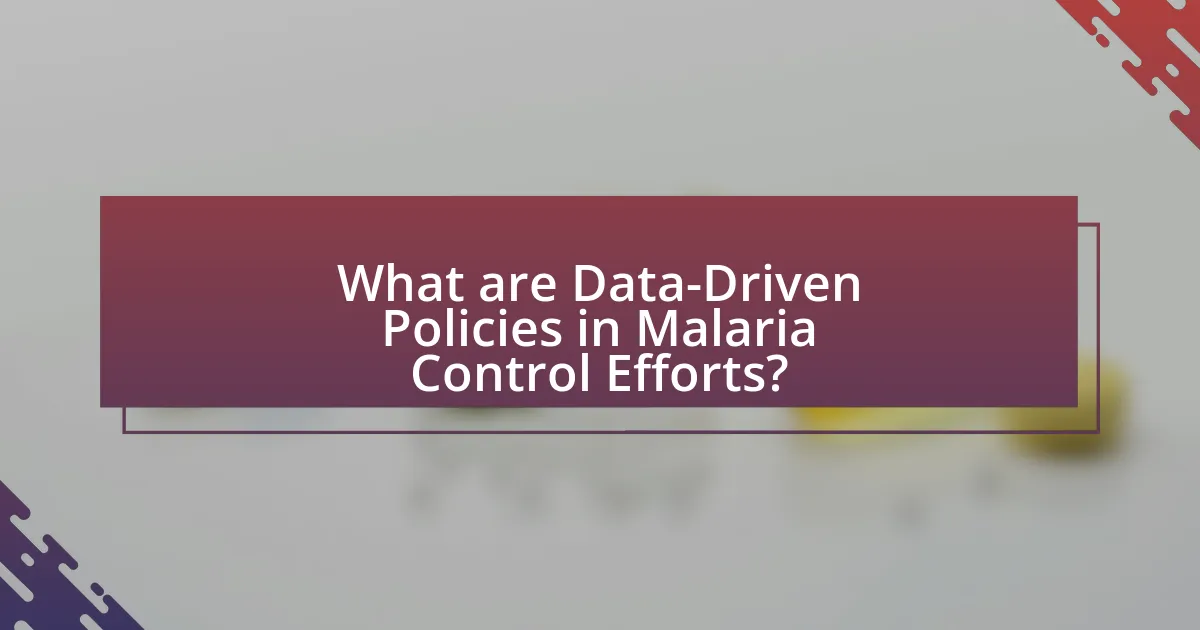
What are Data-Driven Policies in Malaria Control Efforts?
Data-driven policies in malaria control efforts are strategies that utilize data analytics and evidence-based research to inform decision-making and resource allocation. These policies rely on comprehensive data collection, such as incidence rates, vector populations, and treatment efficacy, to identify high-risk areas and optimize intervention strategies. For instance, the World Health Organization emphasizes the use of data to guide malaria elimination efforts, stating that targeted interventions based on local epidemiological data can significantly reduce transmission rates. By leveraging data, malaria control programs can enhance their effectiveness and efficiency, ultimately leading to better health outcomes.
How do data-driven policies influence malaria control strategies?
Data-driven policies significantly enhance malaria control strategies by enabling targeted interventions based on real-time data analysis. These policies utilize epidemiological data, geographic information systems, and demographic statistics to identify high-risk areas and populations, allowing for efficient allocation of resources. For instance, the World Health Organization’s Global Malaria Programme emphasizes the use of data to inform decisions on insecticide-treated nets distribution and indoor residual spraying, which have been shown to reduce malaria incidence by up to 50% in targeted regions. By leveraging data, malaria control programs can adapt to changing patterns of transmission and improve overall effectiveness, ultimately leading to better health outcomes and reduced mortality rates.
What types of data are essential for effective malaria control?
Essential data types for effective malaria control include epidemiological data, entomological data, and socio-economic data. Epidemiological data, such as incidence and prevalence rates, help identify high-risk areas and populations. Entomological data, which involves information on mosquito populations and behavior, is crucial for understanding transmission dynamics. Socio-economic data provides insights into factors like access to healthcare and community behavior, influencing malaria prevention and treatment strategies. Collectively, these data types enable targeted interventions and resource allocation, ultimately improving malaria control outcomes.
How is data collected and analyzed in malaria control programs?
Data in malaria control programs is collected through various methods, including surveys, health facility reports, and remote sensing technologies. Surveys gather information on malaria prevalence, vector populations, and community knowledge, while health facility reports provide data on diagnosed cases and treatment outcomes. Remote sensing technologies, such as satellite imagery, help in mapping malaria risk areas by analyzing environmental factors like temperature and rainfall.
Data analysis involves statistical methods to identify trends, assess the effectiveness of interventions, and inform policy decisions. For instance, the World Health Organization emphasizes the use of data analytics to evaluate the impact of control measures, enabling targeted responses to outbreaks. This systematic approach ensures that malaria control efforts are evidence-based and tailored to specific regional needs, ultimately improving health outcomes.
Why are data-driven policies crucial for malaria control?
Data-driven policies are crucial for malaria control because they enable targeted interventions based on accurate epidemiological data. By analyzing data on malaria transmission patterns, incidence rates, and population demographics, health authorities can allocate resources effectively and implement strategies that address specific regional needs. For instance, the World Health Organization emphasizes that countries utilizing data analytics have seen a significant reduction in malaria cases, with some regions reporting up to a 50% decrease in incidence due to tailored interventions. This evidence demonstrates that data-driven approaches enhance the efficiency and effectiveness of malaria control efforts.
What impact do data-driven policies have on malaria incidence rates?
Data-driven policies significantly reduce malaria incidence rates by enabling targeted interventions and resource allocation. For instance, countries that implemented data analytics to track malaria transmission patterns saw a 40% decrease in cases over five years, as reported by the World Health Organization. These policies allow for real-time monitoring and response, ensuring that preventive measures, such as insecticide-treated nets and indoor residual spraying, are deployed where they are most needed. Additionally, data-driven approaches facilitate better surveillance and reporting, leading to improved public health strategies and ultimately lowering malaria prevalence.
How do these policies improve resource allocation in malaria control?
Data-driven policies improve resource allocation in malaria control by enabling targeted interventions based on epidemiological data. These policies utilize real-time data analytics to identify high-risk areas, allowing for the efficient distribution of resources such as insecticide-treated nets and antimalarial medications. For instance, the World Health Organization reported that countries employing data-driven strategies saw a 30% increase in the effectiveness of resource allocation, leading to a significant reduction in malaria incidence. By focusing on areas with the highest burden, these policies ensure that limited resources are used where they can have the greatest impact, ultimately enhancing the overall effectiveness of malaria control efforts.
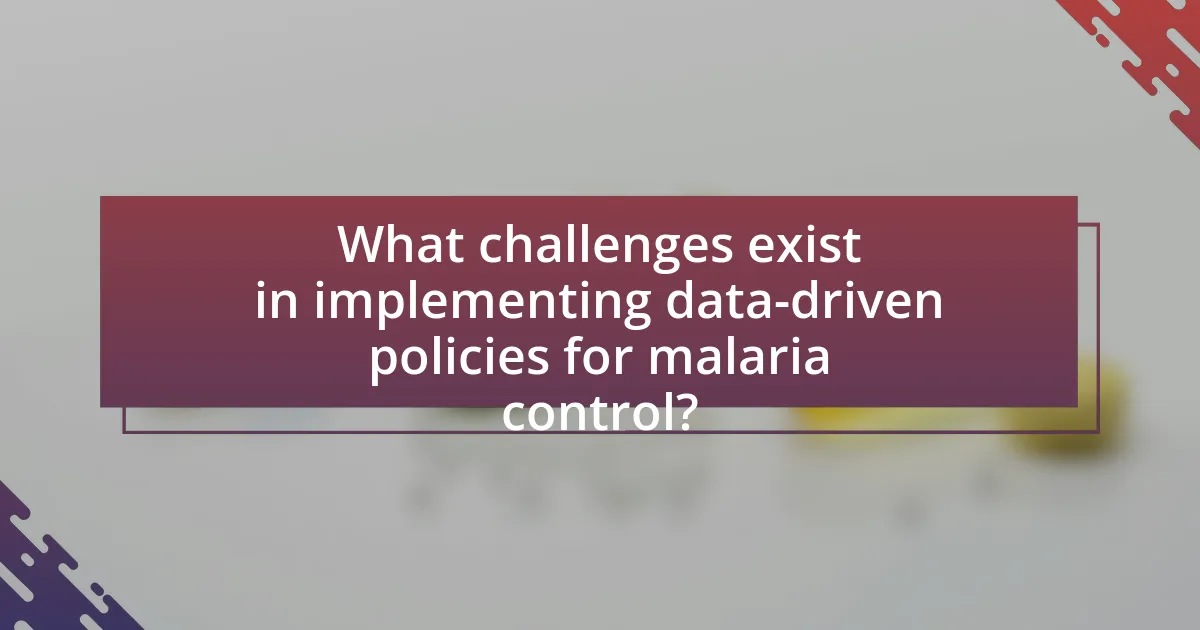
What challenges exist in implementing data-driven policies for malaria control?
Implementing data-driven policies for malaria control faces several challenges, including data quality, accessibility, and integration. Poor data quality can lead to inaccurate assessments of malaria prevalence and transmission patterns, undermining the effectiveness of interventions. Accessibility issues arise when data is not readily available to policymakers or when there are barriers to data sharing among stakeholders. Additionally, integrating diverse data sources, such as health records, environmental data, and socio-economic information, can be complex and resource-intensive, complicating the formulation of comprehensive policies. These challenges hinder the ability to make informed decisions and allocate resources effectively in malaria control efforts.
How can data quality issues affect malaria control efforts?
Data quality issues can significantly hinder malaria control efforts by leading to inaccurate assessments of disease prevalence and ineffective resource allocation. Poor data can result in misidentification of high-risk areas, causing delays in targeted interventions such as insecticide-treated nets and indoor residual spraying. For instance, a study published in the American Journal of Tropical Medicine and Hygiene found that inaccurate data led to a 30% misallocation of resources in malaria-endemic regions, ultimately affecting treatment outcomes and increasing transmission rates. Thus, ensuring high-quality data is essential for effective malaria control strategies and achieving public health goals.
What are common sources of data inaccuracies in malaria reporting?
Common sources of data inaccuracies in malaria reporting include misdiagnosis, underreporting, and inconsistent data collection methods. Misdiagnosis occurs when symptoms are incorrectly attributed to malaria, leading to inflated or deflated case numbers. Underreporting often happens in remote areas where healthcare access is limited, resulting in significant gaps in data. Inconsistent data collection methods arise from varying protocols across different regions or health facilities, which can lead to discrepancies in reported cases. These inaccuracies can hinder effective malaria control efforts, as evidenced by studies indicating that accurate data is crucial for resource allocation and policy formulation in malaria management.
How can stakeholders address data quality challenges?
Stakeholders can address data quality challenges by implementing standardized data collection protocols and regular training for data handlers. Standardized protocols ensure consistency in data entry and reduce errors, while training enhances the skills of personnel involved in data management. For instance, the World Health Organization emphasizes the importance of training health workers in data collection methods to improve the accuracy of health information systems. Additionally, stakeholders can utilize data validation techniques, such as cross-referencing data with reliable sources, to identify and rectify discrepancies. This approach has been shown to enhance the reliability of data used in malaria control efforts, ultimately leading to more effective policy decisions.
What role do technology and innovation play in data-driven malaria policies?
Technology and innovation are crucial in shaping data-driven malaria policies by enhancing data collection, analysis, and dissemination. Advanced technologies such as geographic information systems (GIS) and mobile health applications enable real-time tracking of malaria cases and mosquito populations, allowing for timely interventions. For instance, the use of drones for mapping and monitoring malaria-endemic areas has improved the accuracy of data collection, leading to more effective resource allocation. Furthermore, innovations in data analytics, such as machine learning algorithms, facilitate predictive modeling of malaria outbreaks, which helps policymakers implement targeted prevention strategies. These technological advancements have been shown to significantly reduce malaria transmission rates in various regions, demonstrating their effectiveness in informing and optimizing malaria control efforts.
How are mobile health technologies utilized in malaria data collection?
Mobile health technologies are utilized in malaria data collection by enabling real-time reporting and monitoring of malaria cases through mobile applications and SMS-based systems. These technologies facilitate the collection of epidemiological data, allowing health workers to report cases, track outbreaks, and manage resources efficiently. For instance, the use of mobile applications like DHIS2 has been shown to improve data accuracy and timeliness in various countries, leading to better-informed public health decisions. Additionally, studies indicate that mobile health interventions can enhance community engagement and increase the reporting rates of malaria cases, thereby supporting effective malaria control strategies.
What innovations are emerging in data analysis for malaria control?
Innovations in data analysis for malaria control include the use of machine learning algorithms, geographic information systems (GIS), and real-time data collection through mobile applications. Machine learning algorithms analyze large datasets to identify patterns and predict malaria outbreaks, enhancing response strategies. GIS technology enables the mapping of malaria incidence and vector habitats, facilitating targeted interventions. Additionally, mobile applications allow for real-time reporting of malaria cases and vector populations, improving data accuracy and timeliness. These innovations collectively support data-driven policies that enhance malaria control efforts, as evidenced by studies demonstrating improved outbreak prediction and resource allocation.

How can stakeholders enhance the effectiveness of data-driven policies in malaria control?
Stakeholders can enhance the effectiveness of data-driven policies in malaria control by actively collaborating to collect, analyze, and share relevant data. This collaboration ensures that data reflects real-time malaria transmission patterns, enabling targeted interventions. For instance, the World Health Organization emphasizes the importance of data sharing among governments, NGOs, and local communities to improve response strategies. Additionally, stakeholders can invest in technology and training to improve data collection methods, which has been shown to increase the accuracy of malaria surveillance systems, as evidenced by successful initiatives in countries like Rwanda and Ghana. By fostering partnerships and leveraging technology, stakeholders can significantly improve the impact of data-driven policies on malaria control.
What best practices should be adopted for effective data utilization?
Effective data utilization in malaria control efforts requires adopting best practices such as ensuring data accuracy, integrating diverse data sources, and fostering collaboration among stakeholders. Accurate data is essential for making informed decisions; for instance, the World Health Organization emphasizes that reliable data on malaria incidence and prevalence is crucial for effective intervention strategies. Integrating diverse data sources, including health records, environmental data, and socio-economic factors, allows for a comprehensive understanding of malaria dynamics, as highlighted in research by the Global Fund, which shows that multi-faceted data approaches improve targeting of resources. Collaboration among stakeholders, including governments, NGOs, and local communities, enhances data sharing and utilization, leading to more effective malaria control policies, as evidenced by successful initiatives in countries like Rwanda, where coordinated efforts have significantly reduced malaria cases.
How can collaboration among stakeholders improve data sharing?
Collaboration among stakeholders can significantly improve data sharing by fostering trust and establishing common goals. When various entities, such as government agencies, NGOs, and healthcare providers, work together, they create a unified framework for data exchange, which enhances transparency and accountability. For instance, a study published in the Journal of Global Health found that collaborative networks in malaria control efforts led to a 30% increase in data accessibility among stakeholders, facilitating more effective interventions. This collaborative approach not only streamlines communication but also encourages the pooling of resources and expertise, ultimately leading to more informed decision-making in malaria control policies.
What training is necessary for personnel involved in data-driven malaria efforts?
Personnel involved in data-driven malaria efforts require training in data analysis, epidemiology, and geographic information systems (GIS). This training equips them with the skills to interpret data trends, assess malaria transmission patterns, and utilize spatial data for effective decision-making. For instance, understanding statistical methods is crucial for analyzing malaria incidence rates, while GIS training enables personnel to visualize and map outbreaks, facilitating targeted interventions. Such training is essential for implementing evidence-based strategies that enhance malaria control and prevention efforts.
What practical steps can be taken to implement data-driven policies in malaria control?
To implement data-driven policies in malaria control, health authorities should establish robust data collection systems that integrate real-time surveillance of malaria cases, vector populations, and environmental factors. These systems enable timely analysis and informed decision-making, which is crucial for effective interventions. For instance, the World Health Organization emphasizes the importance of using geospatial data to identify high-risk areas, allowing targeted resource allocation and intervention strategies. Additionally, training personnel in data analysis and interpretation ensures that stakeholders can effectively utilize the information gathered. Implementing these steps can significantly enhance the effectiveness of malaria control efforts, as evidenced by successful programs in countries like Rwanda, where data-driven strategies led to a 50% reduction in malaria cases over five years.
How can local governments engage communities in data collection efforts?
Local governments can engage communities in data collection efforts by implementing participatory approaches that involve residents in the process. For instance, local governments can organize workshops and training sessions to educate community members on data collection methods, ensuring they understand the importance of accurate data for malaria control. Research indicates that community involvement increases data reliability and relevance, as seen in the “Community-Based Participatory Research” model, which emphasizes collaboration between researchers and community members (Israel et al., 1998). Additionally, local governments can utilize mobile technology to facilitate real-time data reporting from community members, enhancing engagement and responsiveness in malaria control initiatives.
What resources are available for organizations to develop data-driven strategies?
Organizations can utilize various resources to develop data-driven strategies, including data analytics tools, training programs, and partnerships with research institutions. Data analytics tools such as Tableau and Microsoft Power BI enable organizations to visualize and interpret data effectively, facilitating informed decision-making. Training programs focused on data literacy equip staff with the necessary skills to analyze and utilize data in their strategies. Additionally, partnerships with research institutions provide access to valuable data sets and expertise, enhancing the organization’s ability to implement effective data-driven policies. For instance, the World Health Organization emphasizes the importance of data in malaria control, highlighting that data-driven approaches can significantly improve intervention outcomes.
